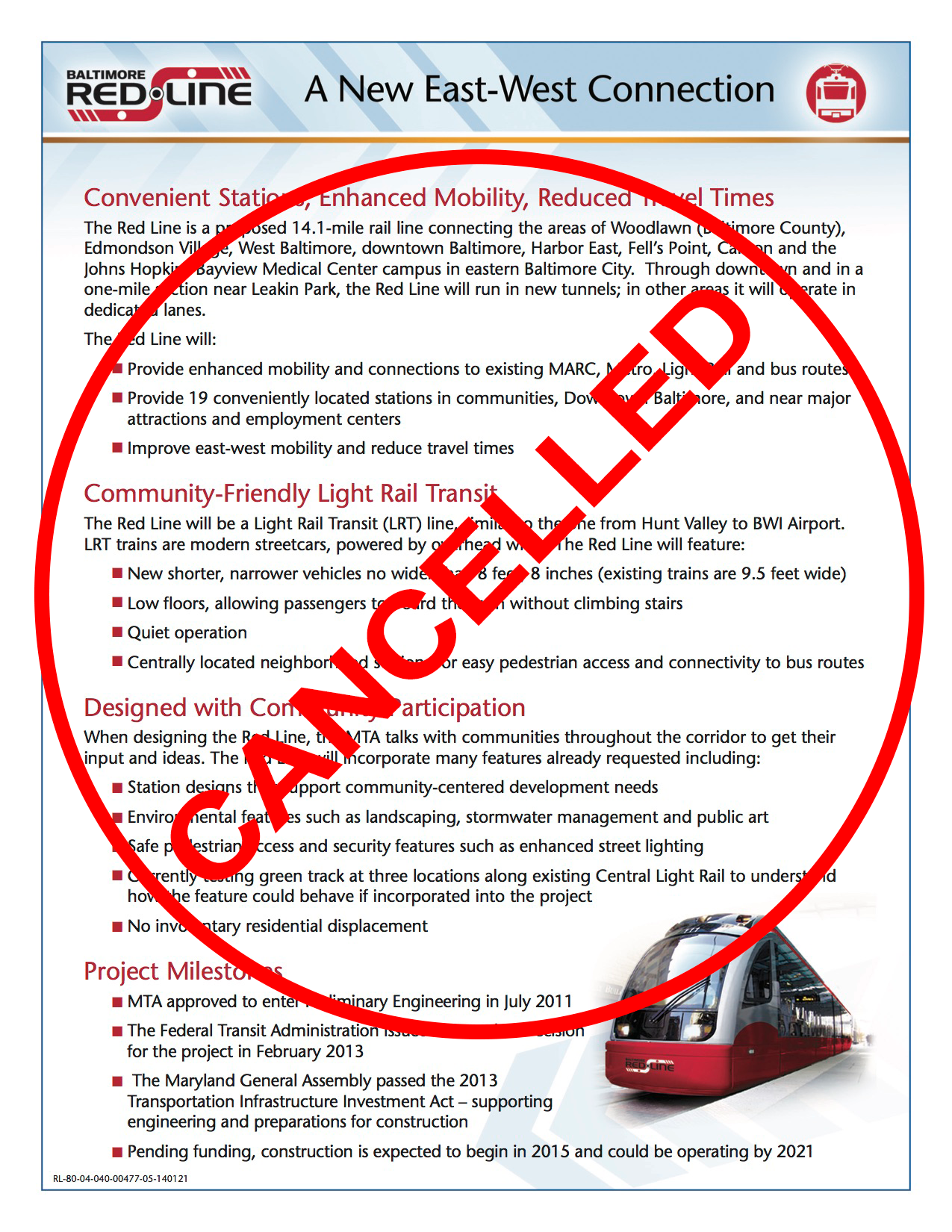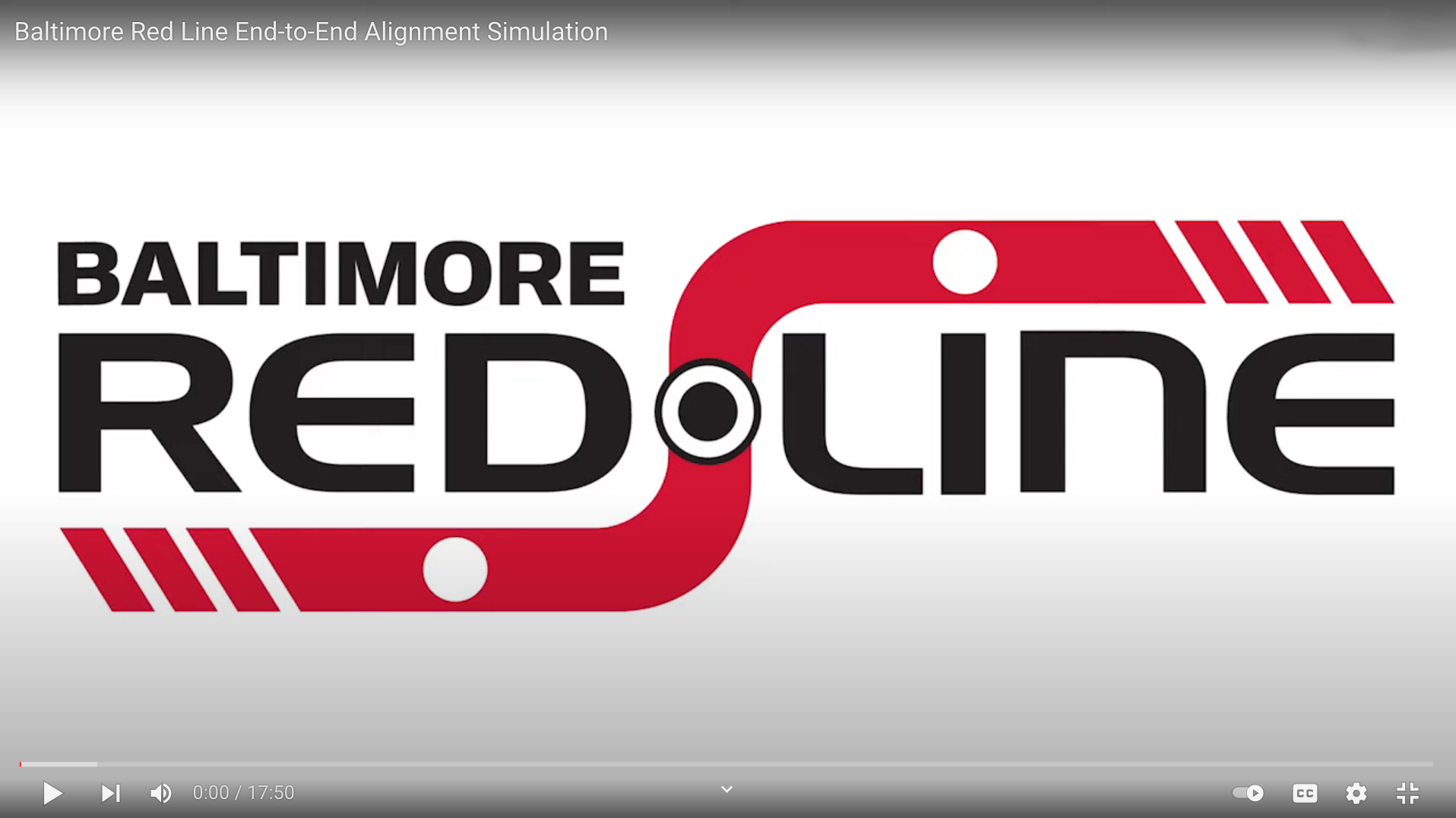RED LINE LIGHT RAIL:
CANCELLATION (AND REBIRTH)
“When Gov. Hogan was elected, he came into office with a $2.95 billion pot of gold on his desk - funding for a new East-West light rail line. He didn’t have to lift a finger to raise one penny for it. But he promptly cancelled the project, gave $900 million back to the federal government, and spent the rest of the money on suburban roads. That’s transit equity in Maryland.”
What Was Lost
The story is well-known in Maryland: a new Republican, suburban, real-estate developer governor who ran on a law-and-order, proficient management of government platform, enters office in a predominately Democratic state and wants to put his marker in the sand. So he cancels one of the state’s biggest infrastructure projects - one that would disproportionately help lower-income African-American communities who rely on a dysfunctional Baltimore public transportation system to get to their essential worker jobs.
Instead, he transfers the money - funds raised by a gas tax he complained about as a candidate, but never sought to repeal as a governor - to suburban road projects favoring overwhelmingly white, wealthier communities. And that’s where it stands today, with one year left on that governor’s second term.
The only large-scale transit infrastructure project Governor Hogan ever favored during his tenure became a disaster when he insisted it be turned into a “public-private partnership” (PPP). Owing to Hogan’s mismanagement, and the subsequent quitting of the “private” side of his PPP partnership, the Purple Line light rail project is now slated to be delivered four-and-a-half years late and ultimately cost the state an additional $3.4 billion, an 80% increase in cost. And to the think the reason he offered for cancelling Baltimore’s Red Line was a complaint over a $1 billion tunnel that was to be built under the city of Baltimore, to speed those light rail trains under that crucial bottleneck. Hogan said it was too expensive.
So that’s the story of political maneuvering, but when it comes to the cancelled Red Line, there’s so much more that was lost:
Nearly $1 billion in federal transit funds, approved and ready for use
Another $300 million the MTA spent in planning, design and land acquisition
Another $135 million the MTA spent in a failed “fig leaf” project called BaltimoreLink that rejiggered some bus lines
13,000 jobs that were estimated to be created as a result of the cancelled Red Line project
$6.5 billion in economic development, estimated for the transit corridor, lost because of the Red Line’s cancellation
14 years and 100’s of hours spent by countless community leaders in planning for the project
Add it all up and, between the two transit projects alone, if Governor Hogan had never come into office, the state would likely be $8-10 billion dollars richer, with thousands more jobs, and two functioning light rail lines in operation. That's $2000 for every man, woman and child in the State of Maryland that Governor Hogan has cost us.
Why do we in HUB West Baltimore care so much? Because that light-rail line was - and is - the critical link connecting not only West Baltimore residents to the downtown, but downtown riders and Baltimore’s east side to the future commercial center of HUB West Baltimore, and the quickest jumping-off point for a commute to Washington: a new multi-modal West Baltimore MARC Station TOD center.
What May Be Again
In 2021, six years after the Red Line’s cancellation, Maryland’s two senators resolved to revive it. And they made concrete steps to do so, by including language in the recently passed federal Infrastructure Bill. According to Senator Van Hollen: “What [the Infrastructure Bill] legislation says is the federal government remains a willing partner and looks forward to working with the State of Maryland, should Maryland choose to go forward with this project.”
So the Red Line will be a campaign issue in the governor’s race heating up now. And with the funds ostensibly in place at the federal level, and environmental approvals already complete, Baltimore could be back on the fast track back to Red Line construction in 2023. But it’ll take strong support by the next governor, and HUB West Baltimore CDC will be working with leaders on the Red Line cause, like the Baltimore Transit Equity Coalition (BTEC), to make sure this issue is front and center in the campaign.
Further Reading and Viewing
- See the Red Line end-to-end simulation video, below. (West Baltimore MARC station at the 07:00 mark.)
- See a Johns Hopkins University/BTEC study showing how transit equity and environmental health in Baltimore are directly linked
- Read the approved Final Environmental Impact Statement
- Read the 2011 West Baltimore MARC Station Vision Plan, authored by the Red Line “Station Area Advisory Committee”
- Read the original Red Line Community Compact (September 12, 2008)
- See then-Maryland Transportation Secretary Peter Rahn get all his figures completely wrong - about the Red Line Tunnel, the Purple Line project, and even the B&P Tunnel (at 55:30)
- See then-Maryland Transportation Secretary Peter Rahn call his coming BaltimoreLink bus realignment a “huge leap forward in transportation for Baltimore” (at 58:00)


